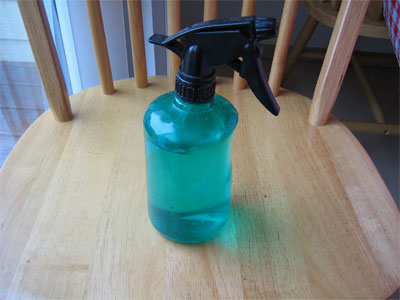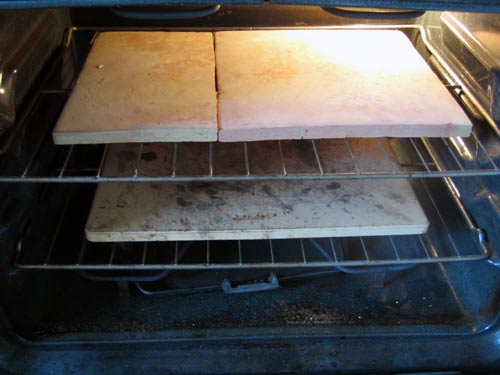Professional bakers have steam injectors inside of their ovens. Right after placing their loaves inside, they give the loaves a good blast of steam. The steam keeps the outside of the loaves moist and supple so that the bread can spring for as long as possible. Once the outside of the loaf begins to dry out it hardens, preventing further spring. Then the crust begins to form.
Home bakers need to get creative to reproduce this effect. Some folks suggest dabbling the loaves with water before placing them in the oven, but I've found this results in a softer crust. For maximum oven spring and a crunchy crust, the trick is to get a lot of steam in the oven early and then have the oven dry out for the remainder of the baking.
A warning: steam is hot. Really really hot. Steam is also wet and many electronic ovens do not like wet. Please use the utmost caution trying any of these techniques, and be aware that damage to person or property can occur as a result of these techniques. Try these at your own risk!
I've use a couple of different tricks to get steam in my oven. The simplest one is:

a squirt bottle. Right after placing the loaves in the oven, give the walls of the oven a good spray of water, being careful not to nail the light bulb or it will explode. The water will evaporate immediately, creating steam.
That didn't create as much steam as I wanted, so I moved on to:

A scrappy old brownie pan that I punched 5 holes in the bottom of. I'd place it below my baking stone for preheating, like this:

When I was putting my bread in the oven I'd pour a cup of hot water in the pan, some of which evaporates immediately and some of which drips onto the bottom of the oven and evaporates there.
That still wasn't creating as much steam as I wanted, so now I am using an iron pan that I picked up a thrift shop. See it at the bottom of my oven, under the heating coil:

That pan gets extremely hot, so when I pour a cup of hot water into it the water evaporates in seconds.
As you can see, you can make use of whatever tools you have handy. Just be careful not to get vapor burns while pouring or spraying the hot water into the vessel.
Also, be aware that some people on this site have had their ovens malfunction after using heavy steam. Newer, more computerized ovens appear to be more vulnerable to moisture related problems. "Baker beware" is the mantra when using this technique: what is good for your crust may end up being bad for your pocketbook!
And, finally, Number 0: Practice.
- Log in to post comments
Comments
Whenever I bake bread, I automatically spray with my water bottle, maybe opening the oven door a couple more times to spray.
Is this tack only for crusty breads, or should we be using it on other types too?
Similarly, regarding the previous comment about temperature, should I not spray breads baked under 400 degrees? Or should I be baking these breads at 450 or so for the first ten minutes with steam?
Give me a context....
Rosalie
IMHO this "lesson" should include
The current information is not only misleading; it's downright dangerous.
I'm not sure what is misleading about it because those do represent the techniques I use and the only time I've gotten burned was using the Dutch Oven technique, but I certainly don't mind adding more of a disclaimer and a link or two to other options.
Can you recommend a post that illustrates a technique you prefer?
My issue is not steam burns (although that's an issue too), but [u]kaputing electronic oven controls[/u]!
Currently on another thread here, a user who borked his oven controls three times and is now in the market for an entirely new oven complained that he had no idea what he was doing was risky until it was way way too late. He's right! The writeup contains no warning about electronic controls - it gives the impressions a) whole-oven steaming is the only possible method and b) everybody can and should do it. It's only after perusing old threads in detail some folks realize that everybody SHOULD NOT and DOES NOT do this, as it risks breaking their oven.
The obvious alternative to whole-oven steaming that I feel should be mentioned is steaming only the bread (or "covering" if you prefer). From what other threads say, this alternative generally produces equally good or usually even better results, yet doesn't risk damaging the oven. This method hasn't gotten a well-known name, and is referred to by a whole variety of monikers including "magic bowl", inverted roaster, upside down foil pan, covered pan such as Dutch Oven, etc. etc.
thanks!
Yeah, this writeup does have a disclaimer about electronic controls and has for at least 3 or 4 years. Right after warning folks to be careful not to burn themselves I wrote:
Also, be aware that some people on this site have had their ovens malfunction after using heavy steam. Newer, more computerized ovens appear to be more vulnerable to moisture related problems. "Baker beware" is the mantra when using this technique: what is good for your crust may end up being bad for your pocketbook!
I added a second disclaimer higher up in the article today.
I have had two ovens with electronic controls at this house and my previous house. I've steamed the bejeesus out of both ovens and never had any malfunctions, which frankly has been disappointing because I've wanted to replace both of them with something better but I'm too cheap to replace something that works just fine. I don't know why mine haven't had problems and other folks have -- they certainly haven't been high end ovens, just run-of-the-mill Whirlpools or Maytags -- but clearly the "your mileage may vary" mantra holds as true here as "baker beware" does.
Again, if you are aware of good demonstrations of the covered/foil/Dutch Oven techniques here I'll gladly link to them.
I do the cast iron pan thing myself, but have never heard of adding weights. What's the purpose of them? Is it to add more mass to ask as a heat sink or to increase surface area for evaporation?
YES, the more steam that is created the better, so by creating the surface area in which the ice can melt, more steam is produced. I took the Parisian Bread course at FCI as well, and that's the technique they told us to do to try to replicate the crusty baguettes we produced in class at home. Also, be sure to cover the glass with a towel when adding the ice..precaution. For me, instead of using the chains as suggested, am gonna use the lava rock on a rectangular tray heated at the same length of time as my 15x20 stone. bicycle chains have also been suggested.
Great! Thanks for the insight. Lavarocks sound like an awesome idea, as I figure the porosity would probably allow a little more water to be added without having too big of a pool sitting in the bottom of the pan. I use the suggestion in BBA to use boiling water rather than ice, which creates instant steam, but I feel like the steam is gone way too quickly.
I have assembled a baking stone from smaller 6 x 6 stones from http://www.californiapizzastones.com/. Quite by accident I found out that I can pour water directly on the stones (I was aiming for the pan below). ;-)
The amount of steam was quite large (at 500 degrees it should be).
Curious if anyone is using a separate stone(s) onto which to either pour or spray water? I am planning on obtaining a small long necked pot to see if I can locate the steam source further to the back of the oven.
Thanks!
Patrick
I have a rectangular one as you have in the picture, but I also have fireplace bricks. You guy them very very inexpensively at a cement yard. I layed mine out on a flat surface and picked out only the ones that were edge to edge perfect and no cracks.
Here on LI in NY gas ovens all go to 550, electrics go to 500. ZOE line the oven turn it on as hot as possible, let it bake for 30 minutes For pizza you can drop a pie right on it, or you can use a pie plate matters not. That oven is 550 and the stones work like magic.
Tricks , wet dough minimal handling little/no fats in the dough Chill the dough at least 5 hours.
At 550 degrees I spin the pie at 4 minutes and it is done at 8 minutes, more or less. This is a moderately thin pie, cold dough, cold sauce cold cheese.
Bricks are great in the gas grill. One year I made 3 pies 1 pear two apple in the middle of August (ugghh). I have no AC so this was done in my Webber Gas grill. Preheat 1/2 hour to 450 then put double crust fruit pies on the bricks that lined my grill........mmmmmmm
justy a thought
I understand that steam in the oven is to keep the loaf surface supple to maximize the spring effect. Besides this, does the stem create a thicker chewy crust (as in an artisan country loaf), or a thin crispy crust (as in a Vietnamese baguette)?
I wouldn't fret it. My stone lasted over a year of heavy use zero steam, then cracked into 3 fairly even pieces one day for no apparent reason. Now it fits in the cupboard waaay easier and and can be put back together in about 2 seconds when using it. Honestly its definitely more practical now with no discernable downside.
Go for it and if it breaks a whole new world of storage options awaits.
I've been using a cast-iron saute pan that I own to add steam, but it gets rusty every time, which is a problem, since I also use it for cooking. Is there a way to avoid rust, or do I just need to get a dedicated pan? Will the rust cause any problems in baking?
Unless you really enjoy reseasoning your cast iron pan repeatedly, find another pan. I use the broiler pan that came with my oven. It's broad, shallow, and enameled. There's a lot of surface area for steam generation and it doesn't rust. All I do is wipe off the mineral deposits after each use.
Paul